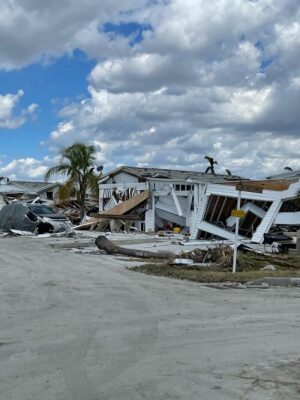When Climate Disaster Strikes, How Distributed Energy Can Help

When climate-change caused disaster strikes–knocking out power–clean, distributed energy can create electric sanctuaries that are sometimes life-saving.
Solar, energy storage, wind and other renewable resources can power hospitals, keep medical devices charged, ensure food stays cool and provide for air conditioning or heat.
As a co-founder and editor of the news site Microgrid Knowledge, I’ve been covering the ways that distributed energy and microgrids–which can operate independently of the grid–have helped out during outages due to wildfires, hurricanes and storms. Often, when the power is out, homeowners and businesses fire up polluting gas or diesel generators, which only serves to worsen climate change. Distributed energy and microgrids can save lives and keep the lights on without polluting and contributing to climate change.
Here are some of the stories I’ve written recently:
- “We have to do something,” Will Heegaard, operations manager for Footprint Project — a nonprofit that provides solar microgrids and other emergency power systems to disaster areas — told Paul Shmotolokha just hours after Russia launched its invasion of Ukraine on Feb. 24.
Heegaard and Shmotolokha — a Ukrainian-American and CEO of New Use Energy — are no strangers to disaster. New Use Energy provides solar microgrids, solar headlamps, humanitarian aid and other products to regions hit by hurricanes and other crises, often supplying emergency power systems to Footprint Project. With the help of New Use Energy and others, Footprint Project has jumped into action to provide solar generators for communities affected by Hurricane Ida, for desperate Texans during the state’s February 2021 deep freeze and other crises.
Read the story here:
These 2 Organizations Acted Quickly to Provide Solar Microgrids to Ukraine
- Microgrids created electric sanctuaries in Florida, Georgia, Virginia and the Carolinas after Hurricane Ian made landfall in southwest Florida Sept. 27, packing winds as high as 155 MPH. The storm knocked out power to more than 2 million people, leveled homes and sparked floods and water shortages while sending sharks swimming through streets. Microgrids kept power flowing in at least three residential communities, plus retail establishments, medical facilities, a university and manufacturing operations in the four states.
Read the story here:
Microgrids Created Electric Sanctuaries Amidst the Devastation of Hurricane Ian
- During the outages that have hobbled Puerto Rico since Hurricane Fiona hit September 18, a fire station and 45 residents on the island of Culebra have benefited from power supplied by microgrids — and have shared the wealth with their neighbors, many of them still without electricity.
Read the story here:
In Storm-Ravaged Puerto Rico, Those with Microgrids Help Those Without
- In the rural, mountainous regions of central Puerto Rico — which are the first areas to lose power and the last to regain it after storms — young people are leaving because outages undermine their ability to work, stay healthy and enjoy their daily lives.
Read the story here:
Will Microgrids Keep Young People From Abandoning Puerto Rican Towns?
- Texas captured worldwide attention in February when a devastating storm crippled the state’s power system. But at about the same time, and to much less fanfare, part of the Northwest struggled with similar issues. Portland, Oregon, experienced power outages because of severe weather that left about 200,000 customers in the dark, some for several days.
Read the story here:
Not Only Texas Went Dark in February